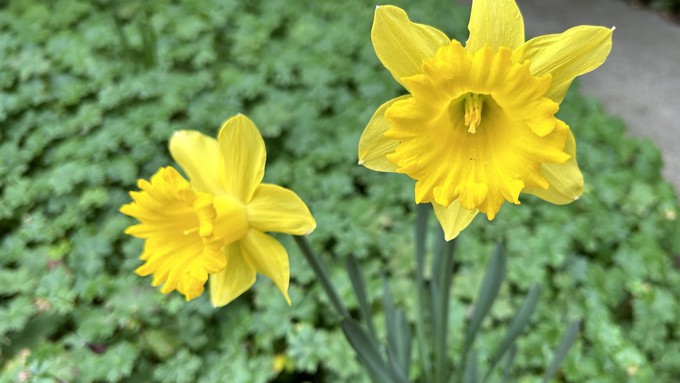
February has been very wet; warmer (and dry) weather is on its way

Expect to see more daffodils and other spring flowers during the warmer, drier days ahead. Kathy Morrison
Looking at my rain gauge, I keep thinking: Are we there yet? How much is enough?
It’s been another soggy few days in California with some places getting way wetter than usual, leading to mudslides and sinkholes.
Here in Sacramento, it’s just been really rainy. The latest pair of atmospheric rivers dropped 2.25 inches over the long Presidents’ Day Weekend including a record 1.14 inches in downtown Sacramento on Sunday, Feb. 18.
Through Feb. 20, Sacramento received 4.49 inches, according to the National Weather Service. That’s about 2 inches more than normal for that same time period.
But overall, our water year – Oct. 1 through Sept. 30 – is tracking just ahead of average. Since Oct. 1, Sacramento has totaled 13.67 inches of rain; normal for that period is 12.12.
Although our rain totals are above normal, we’re not there yet – “there” being a final rain total. Sacramento gets 19.2 inches in an average water year. We’re still more than 5 inches from that benchmark – but we have more than seven months to get there.
Despite another rainy February, this winter has been mild compared to 2022-23. That wet and wild water year totaled 26.22 inches in Sacramento, 36.5% above average.
Warmer, drier days are on their way. According to the weather service, Sacramento will get a sunny break from rain through at least Sunday night. Sacramento might even hit 70 degrees on Saturday.
Expect to see an abundance of daffodils as well as other spring blooms.
That spring-like weather will make it tempting to plant warm-season crops or move tomato seedlings outdoors – but don’t. Soil temperatures, hovering around 54 degrees, are still too chilly for summer vegetables. Soil needs warm nights as well as days before it warms significantly.
And more cold nights are in the forecast, says the weather service. Sacramento’s overnight lows will dip down to as low as 41 degrees by Tuesday (Feb. 27) with several nights this week in the low 40s.
Keep baby tomato, eggplant and pepper plants inside where they’ll appreciate the extra (and consistent) warmth.
For more on Sacramento weather: https://www.weather.gov/sto/#.
Comments
0 comments have been posted.Sacramento Digs Gardening to your inbox.
Food in My Back Yard Series
April 29: What's (already) wrong with my tomato plants?
April 22: Should you stock up on fertilizer? (Yes!)
April 15: Grow culinary herbs in containers
April 8: When to plant summer vegetables
April 1: Don't be fooled by these garden myths
March 25: Fertilizer tips: How to 'feed' your vegetables for healthy growth
March 18: Time to give vegetable seedlings some more space
March 11: Ways to win the fight against weeds
March 4: Potatoes from the garden
Feb. 25: Plant a fruit tree now -- for later
Feb. 18: How to squeeze more food into less space
Feb. 11: When to plant? Consider staggering your transplants
Feb. 4: Starting in seed starting
Sites We Like
Garden Checklist for week of May 4
Enjoy this spring weather – and get gardening!
* Plant, plant, plant! It’s prime planting season in the Sacramento area. Time to set out those tomato transplants along with peppers and eggplants. Pinch off any flowers on new transplants to make them concentrate on establishing roots instead of setting premature fruit.
* Direct-seed melons, cucumbers, summer squash, corn, radishes, pumpkins and annual herbs such as basil.
* Harvest cabbage, lettuce, peas and green onions.
* In the flower garden, direct-seed sunflowers, cosmos, salvia, zinnias, marigolds, celosia and asters. (You also can transplant seedlings for many of the same flowers.)
* Plant dahlia tubers. Other perennials to set out include verbena, coreopsis, coneflower and astilbe.
* Transplant petunias, marigolds and perennial flowers such as astilbe, columbine, coneflowers, coreopsis, dahlias, rudbeckia and verbena.
* Keep an eye out for slugs, snails, earwigs and aphids that want to dine on tender new growth.
* Feed summer bloomers with a balanced fertilizer.
* For continued bloom, cut off spent flowers on roses as well as other flowering plants.
* Add mulch to the garden to maintain moisture. Mulch also cuts down on weeds. But don’t let it mound around the stems or trunks of trees or shrubs. Leave about a 6-inch to 1-foot circle to avoid crown rot or other problems.